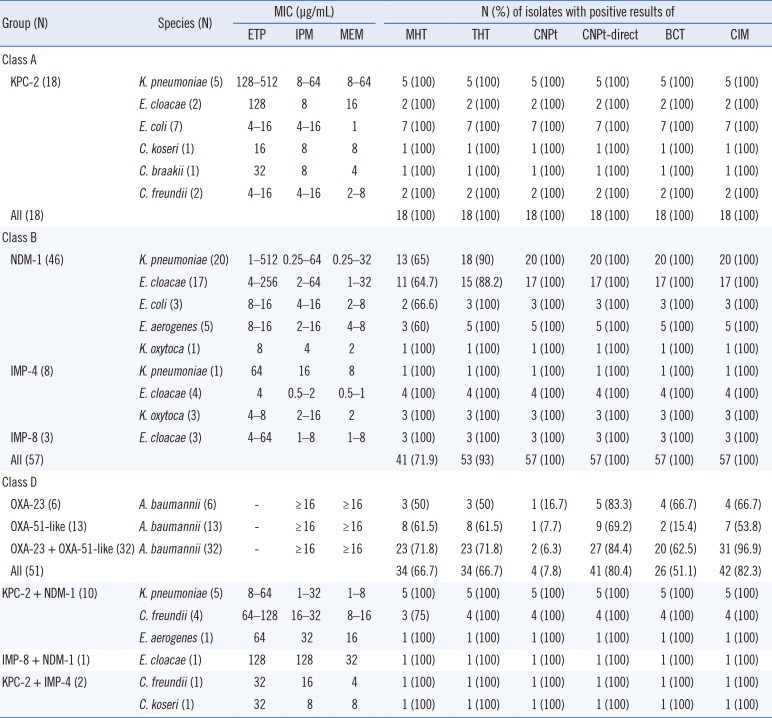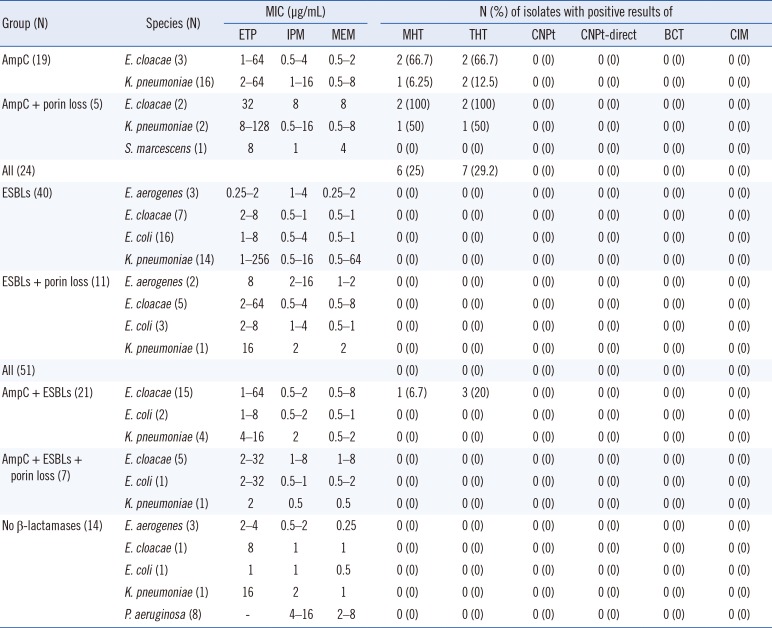1. Bush K, Fisher JF. Epidemiological expansion, structural studies, and clinical challenges of new β-lactamases from gram-negative bacteria. Annu Rev Microbiol. 2011; 65:455–478. PMID:
21740228.
2. Nordmann P, Dortet L, Poirel L. Rapid detection of extended-spectrum-β-lactamase-producing
Enterobacteriaceae. J Clin Microbiol. 2012; 50:3016–3022. PMID:
22760052.
3. Carattoli A. Plasmids and the spread of resistance. Int J Med Microbiol. 2013; 303:298–304. PMID:
23499304.
4. Clinical and Laboratory Standards Institute. Performance standards for antimicrobial susceptibility testing. Twenty-fifth Informational supplement M100-S25. Wayne, PA: CLSI;2015.
5. Pasteran F, Gonzalez LJ, Albornoz E, Bahr G, Vila AJ, Corso A. Triton Hodge test: improved protocol for modified Hodge test for enhanced detection of NDM and other carbapenemase producers. J Clin Microbiol. 2016; 54:640–649. PMID:
26719442.
6. Dortet L, Agathine A, Naas T, Cuzon G, Poirel L, Nordmann P. Evaluation of the RAPIDEC® CARBA NP, the Rapid CARB Screen® and the Carba NP test for biochemical detection of carbapenemase-producing
Enterobacteriaceae. J Antimicrob Chemother. 2015; 70:3014–3022. PMID:
26260131.
7. Pasteran F, Tijet N, Melano RG, Corso A. Simplified protocol for Carba NP test for enhanced detection of carbapenemase producers directly from bacterial cultures. J Clin Microbiol. 2015; 53:3908–3911. PMID:
26424841.
8. Pires J, Novais A, Peixe L. Blue-carba, an easy biochemical test for detection of diverse carbapenemase producers directly from bacterial cultures. J Clin Microbiol. 2013; 51:4281–4283. PMID:
24108615.
9. Pasteran F, Veliz O, Ceriana P, Lucero C, Rapoport M, Albornoz E, et al. Evaluation of the Blue-Carba test for rapid detection of carbapenemases in gram-negative bacilli. J Clin Microbiol. 2015; 53:1996–1998. PMID:
25809971.
10. van der Zwaluw K, de Haan A, Pluister GN, Bootsma HJ, de Neeling AJ, Schouls LM. The carbapenem inactivation method (CIM), a simple and low-cost alternative for the Carba NP test to assess phenotypic carbapenemase activity in gram-negative rods. PLoS One. 2015; 10:e0123690. PMID:
25798828.
11. Yan Q, Liu Q, Li Y, Li H, Liang X, Zou M, et al. Detection of carbapenemase-producing gram-negative bacteria using a simplified Carba NP test. J Microbiol Methods. 2016; 123:1–3. PMID:
26854838.
12. Pires J, Tinguely R, Thomas B, Luzzaro F, Endimiani A. Comparison of the in-house made Carba-NP and Blue-Carba tests: Considerations for better detection of carbapenemase-producing
Enterobacteriaceae. J Microbiol Methods. 2016; 122:33–37. PMID:
26773493.
13. Tijet N, Patel SN, Melano RG. Detection of carbapenemase activity in
Enterobacteriaceae: comparison of the carbapenem inactivation method versus the Carba NP test. J Antimicrob Chemother. 2016; 71:274–276. PMID:
26374613.
14. Poirel L, Walsh TR, Cuvillier V, Nordmann P. Multiplex PCR for detection of acquired carbapenemase genes. Diagn Microbiol Infect Dis. 2011; 70:119–123. PMID:
21398074.
15. Woodford N, Ellington MJ, Coelho JM, Turton JF, Ward ME, Brown S, et al. Multiplex PCR for genes encoding prevalent OXA carbapenemases in
Acinetobacter spp. Int J Antimicrob Agents. 2006; 27:351–353. PMID:
16564159.
16. Zhang C, Xu X, Pu S, Huang S, Sun J, Yang S, et al. Characterization of carbapenemases, extended spectrum β-lactamases, quinolone resistance and aminoglycoside resistance determinants in carbapenem-non-susceptible
Escherichia coli from a teaching hospital in Chongqing, Southwest China. Infect Genet Evol. 2014; 27:271–276. PMID:
25107431.
17. Kim HK, Park JS, Sung H, Kim MN. Further modification of the modified Hodge test for detecting metallo-β-lactamase-producing carbapenem-resistant
Enterobacteriaceae. Ann Lab Med. 2015; 35:298–305. PMID:
25932437.
18. Vasoo S, Cunningham SA, Kohner PC, Simner PJ, Mandrekar JN, Lolans K, et al. Comparison of a novel, rapid chromogenic biochemical assay, the Carba NP test, with the modified Hodge test for detection of carbapenemase-producing Gram-negative bacilli. J Clin Microbiol. 2013; 51:3097–3101. PMID:
23824767.
19. Lifshitz Z, Adler A, Carmeli Y. Comparative study of a novel biochemical assay, the Rapidec Carba NP test, for detecting carbapenemase-producing
Enterobacteriaceae. J Clin Microbiol. 2016; 54:453–456. PMID:
26582833.
20. Desu MM, Raghavarao D. Sample size methodology. New York: Academic Press;1990.
21. Heinrichs A, Huang TD, Berhin C, Bogaerts P, Glupczynski Y. Evaluation of several phenotypic methods for the detection of carbapenemase-producing
Pseudomonas aeruginosa. Eur J Clin Microbiol Infect Dis. 2015; 34:1467–1474. PMID:
25896858.
22. Genc O, Aksu E, Gulcan A. The identification of carbapenemase types in
Enterobacteriaceae by using molecular assay and phenotyping confirmation tests. J Microbiol Methods. 2016; 125:8–11. PMID:
27015750.
23. Dortet L, Poirel L, Errera C, Nordmann P. CarbAcineto NP test for rapid detection of carbapenemase-producing
Acinetobacter spp. J Clin Microbiol. 2014; 52:2359–2364. PMID:
24759709.
24. Bush K, Fisher JF. Epidemiological expansion, structural studies, and clinical challenges of new β-lactamases from gram-negative bacteria. Annu Rev Microbiol. 2011; 65:455–478. PMID:
21740228.







 PDF
PDF ePub
ePub Citation
Citation Print
Print


 XML Download
XML Download